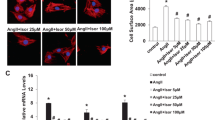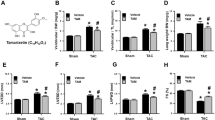Abstract
Isoliquiritigenin (ISL) is a type of flavonoid, derived from the root of the legume plant Glycyrrhiza, that has multiple pharmacological properties. However, its role in cardiac remodeling induced by pressure overload has yet to be fully elucidated. Aortic banding (AB) surgery was used to establish a cardiac hypertrophy model in male C57BL/6 mice. Mice were randomly divided into four groups (n = 20 per group) as follows: Sham + vehicle, sham + ISL, AB + vehicle and AB + ISL. ISL was administered to the mice intragastrically for 1 week after the operation. To evaluate the role of ISL in mice challenged with AB, echocardiography, histological analysis and molecular biochemistry examinations were performed. ISL treatment decreased cardiac hypertrophy and improved cardiac dysfunction induced by pressure overload. In addition, ISL decreased the cross-sectional area of cardiomyocytes. Furthermore, ISL reversed the AB-mediated increase in phosphorylated (p-)mTOR and p-ERK protein levels and further increased the protein expression of p-AMP-activated protein kinase (AMPK)α in response to AB, whereas knockout of AMPKα abolished the protective effects of ISL. The present study suggested that ISL could suppress pressure overload-induced cardiac hypertrophy through the activation of AMPKα. Therefore, ISL may serve as a therapeutic target for cardiac remodeling.






Similar content being viewed by others
Data availability
The analyzed datasets generated in the present study are available from the corresponding author upon reasonable request.
References
An W, Yang J, Ao Y (2006) Metallothionein mediates cardioprotection of isoliquiritigenin against ischemia-reperfusion through JAK2/STAT3 activation. Acta Pharmacol Sin 27(11):1431–1437. https://doi.org/10.1111/j.1745-7254.2006.00419.x
Cao Y, Wang Y, Ji C, Ye J (2004) Determination of liquiritigenin and isoliquiritigenin in Glycyrrhiza uralensis and its medicinal preparations by capillary electrophoresis with electrochemical detection. J Chromatogr A 1042(1–2):203–209. https://doi.org/10.1016/j.chroma.2004.05.049
Chan AY, Soltys CL, Young ME, Proud CG, Dyck JR (2004) Activation of AMP-activated protein kinase inhibits protein synthesis associated with hypertrophy in the cardiac myocyte. J Biol Chem 279(31):32771–32779. https://doi.org/10.1074/jbc.M403528200
Chowdhury SA, Kishino K, Satoh R, Hashimoto K, Kikuchi H, Nishikawa H, Shirataki Y, Sakagami H (2005) Tumor-specificity and apoptosis-inducing activity of stilbenes and flavonoids. Anticancer Res 25(3B):2055–2063
Du F, Gesang Q, Cao J, Qian M, Ma L, Wu D, Yu H (2016) Isoliquiritigenin attenuates atherogenesis in apolipoprotein E-deficient mice. Int J Mol Sci 17(11):1932. https://doi.org/10.3390/ijms17111932
Gu X, Shi Y, Chen X, Sun Z, Luo W, Hu X, Jin G, You S, Qian Y, Wu W, Liang G, Wu G, Chen Z, Chen X (2020) Isoliquiritigenin attenuates diabetic cardiomyopathy via inhibition of hyperglycemia-induced inflammatory response and oxidative stress. Phytomedicine 78:153319. https://doi.org/10.1016/j.phymed.2020.153319
He C, Zhu H, Li H, Zou MH, Xie Z (2013) Dissociation of Bcl-2-Beclin1 complex by activated AMPK enhances cardiac autophagy and protects against cardiomyocyte apoptosis in diabetes. Diabetes 62(4):1270–1281. https://doi.org/10.2337/db12-0533
Hsu YW, Chen HY, Chiang YF, Chang LC, Lin PH, Hsia SM (2020) The effects of isoliquiritigenin on endometriosis in vivo and in vitro study. Phytomedicine 77:153214. https://doi.org/10.1016/j.phymed.2020.153214
Hwang JT, Kwon DY, Park OJ, Kim MS (2008) Resveratrol protects ROS-induced cell death by activating AMPK in H9c2 cardiac muscle cells. Genes Nutr 2(4):323–326. https://doi.org/10.1007/s12263-007-0069-7
Jaiswal A, Nguyen VQ, Carry BJ, le Jemtel TH (2016) Pharmacologic and endovascular reversal of left ventricular remodeling. J Card Fail 22(10):829–839. https://doi.org/10.1016/j.cardfail.2016.03.017
Jiang DS, Wei X, Zhang XF, Liu Y, Zhang Y, Chen K, Gao L, Zhou H, Zhu XH, Liu PP, Bond Lau W, Ma X, Zou Y, Zhang XD, Fan GC, Li H (2014) IRF8 suppresses pathological cardiac remodelling by inhibiting calcineurin signalling. Nat Commun 5:3303. https://doi.org/10.1038/ncomms4303
Jin XY, Sohn DH, Lee SH (2016) Isoliquiritigenin suppresses tumor necrosis factor-α-induced inflammation via peroxisome proliferator-activated receptor-γ in intestinal epithelial cells. Arch Pharm Res 39(10):1465–1471. https://doi.org/10.1007/s12272-016-0805-x
Jørgensen SB, Nielsen JN, Birk JB, Olsen GS, Viollet B, Andreelli F, Schjerling P, Vaulont S, Hardie DG, Hansen BF, Richter EA, Wojtaszewski JF (2004) The alpha2-5′AMP-activated protein kinase is a site 2 glycogen synthase kinase in skeletal muscle and is responsive to glucose loading. Diabetes 53(12):3074–3081. https://doi.org/10.2337/diabetes.53.12.3074
Lakdawala NK, Givertz MM (2010) Dilated cardiomyopathy with conduction disease and arrhythmia. Circulation 122(5):527–534. https://doi.org/10.1161/CIRCULATIONAHA.109.892240
Li J, Hu X, Selvakumar P, Russell RR 3rd, Cushman SW, Holman GD, Young LH (2004) Role of the nitric oxide pathway in AMPK-mediated glucose uptake and GLUT4 translocation in heart muscle. Am J Physiol Endocrinol Metab 287(5):E834–E841. https://doi.org/10.1152/ajpendo.00234.2004
Li D, Wang Z, Chen H, Wang J, Zheng Q, Shang J, Li J (2009) Isoliquiritigenin induces monocytic differentiation of HL-60 cells. Free Radic Biol Med 46(6):731–736. https://doi.org/10.1016/j.freeradbiomed.2008.11.011
Li J, Yuan YP, Xu SC, Zhang N, Xu CR, Wan CX, Ren J, Zeng XF, Tang QZ (2017) Arctiin protects against cardiac hypertrophy through inhibiting MAPKs and AKT signaling pathways. J Pharmacol Sci 135(3):97–104. https://doi.org/10.1016/j.jphs.2017.05.012
Liu XY, Liao HH, Feng H, Zhang N, Yang JJ, Li WJ, Chen S, Deng W, Tang QZ (2018) Icariside II attenuates cardiac remodeling via AMPKα2/mTORC1 in vivo and in vitro. J Pharmacol Sci 138(1):38–45. https://doi.org/10.1016/j.jphs.2018.08.010
Ma ZG, Dai J, Wei WY, Zhang WB, Xu SC, Liao HH, Yang Z, Tang QZ (2016a) Asiatic acid protects against cardiac hypertrophy through activating AMPKα signalling pathway. Int J Biol Sci 12(7):861–871. https://doi.org/10.7150/ijbs.14213
Ma ZG, Dai J, Zhang WB, Yuan Y, Liao HH, Zhang N, Bian ZY, Tang QZ (2016b) Protection against cardiac hypertrophy by geniposide involves the GLP-1 receptor/AMPKα signalling pathway. Br J Pharmacol 173(9):1502–1516. https://doi.org/10.1111/bph.13449
National Research Council (US) Institute for Laboratory Animal Research (1996) Guide for the care and use of laboratory animals. National Academies Press (US), Washington, DC
Russell RR 3rd, Li J, Coven DL, Pypaert M, Zechner C, Palmeri M, Giordano FJ, Mu J, Birnbaum MJ, Young LH (2004) AMP-activated protein kinase mediates ischemic glucose uptake and prevents postischemic cardiac dysfunction, apoptosis, and injury. J Clin Investig 114(4):495–503. https://doi.org/10.1172/JCI19297
Shi L, Zhu D, Wang S, Jiang A, Li F (2019) Dapagliflozin attenuates cardiac remodeling in mice model of cardiac pressure overload. Am J Hypertens 32(5):452–459. https://doi.org/10.1093/ajh/hpz016
Sugden PH, Clerk A (1998) “Stress-responsive” mitogen-activated protein kinases (c-Jun N-terminal kinases and p38 mitogen-activated protein kinases) in the myocardium. Circ Res 83(4):345–352. https://doi.org/10.1161/01.res.83.4.345
Völkers M, Konstandin MH, Doroudgar S, Toko H, Quijada P, Din S, Joyo A, Ornelas L, Samse K, Thuerauf DJ, Gude N, Glembotski CC, Sussman MA (2013) Mechanistic target of rapamycin complex 2 protects the heart from ischemic damage. Circulation 128(19):2132–2144. https://doi.org/10.1161/CIRCULATIONAHA.113.003638
Wang HB, Duan MX, Xu M, Huang SH, Yang J, Yang J, Liu LB, Huang R, Wan CX, Ma ZG, Wu QQ, Tang QZ (2019) Cordycepin ameliorates cardiac hypertrophy via activating the AMPKα pathway. J Cell Mol Med 23(8):5715–5727. https://doi.org/10.1111/jcmm.14485
Xiong D, Hu W, Ye ST, Tan YS (2018) Isoliquiritigenin alleviated the Ang II-induced hypertensive renal injury through suppressing inflammation cytokines and oxidative stress-induced apoptosis via Nrf2 and NF-κB pathways. Biochem Biophys Res Commun 506(1):161–168. https://doi.org/10.1016/j.bbrc.2018.09.013
Zarrinpashneh E, Beauloye C, Ginion A, Pouleur AC, Havaux X, Hue L, Viollet B, Vanoverschelde JL, Bertrand L (2008) AMPKalpha2 counteracts the development of cardiac hypertrophy induced by isoproterenol. Biochem Biophys Res Commun 376(4):677–681. https://doi.org/10.1016/j.bbrc.2008.09.057
Zhang X, Yeung ED, Wang J, Panzhinskiy EE, Tong C, Li W, Li J (2010) Isoliquiritigenin, a natural anti-oxidant, selectively inhibits the proliferation of prostate cancer cells. Clin Exp Pharmacol Physiol 37(8):841–847. https://doi.org/10.1111/j.1440-1681.2010.05395.x
Zhang X, Zhu P, Zhang X, Ma Y, Li W, Chen JM, Guo HM, Bucala R, Zhuang J, Li J (2013) Natural antioxidant-isoliquiritigenin ameliorates contractile dysfunction of hypoxic cardiomyocytes via AMPK signaling pathway. Mediat Inflamm 2013:390890. https://doi.org/10.1155/2013/390890
Zhou Q, Pan LL, Xue R, Ni G, Duan Y, Bai Y, Shi C, Ren Z, Wu C, Li G, Agerberth B, Sluijter JP, Sun J, Xiao J (2020) The anti-microbial peptide LL-37/CRAMP levels are associated with acute heart failure and can attenuate cardiac dysfunction in multiple preclinical models of heart failure. Theranostics 10(14):6167–6181. https://doi.org/10.7150/thno.46225
Zhu Y, Pires KM, Whitehead KJ, Olsen CD, Wayment B, Zhang YC, Bugger H, Ilkun O, Litwin SE, Thomas G, Kozma SC, Abel ED (2013) Mechanistic target of rapamycin (Mtor) is essential for murine embryonic heart development and growth. PLoS ONE 8(1):e54221. https://doi.org/10.1371/journal.pone.0054221
Zimmermann M (1983) Ethical guidelines for investigations of experimental pain in conscious animals. Pain 16(2):109–110. https://doi.org/10.1016/0304-3959(83)90201-4
Zou MH, Hou XY, Shi CM, Kirkpatick S, Liu F, Goldman MH, Cohen RA (2003) Activation of 5′-AMP-activated kinase is mediated through c-Src and phosphoinositide 3-kinase activity during hypoxia-reoxygenation of bovine aortic endothelial cells. Role of peroxynitrite. J Biol Chem 278(36):34003–34010. https://doi.org/10.1074/jbc.M300215200
Acknowledgements
Not applicable.
Funding
Not applicable.
Author information
Authors and Affiliations
Contributions
MLG, QC, SS, and TLD contributed to the conception of the study. MLG, HCS, HXW, MML, and SS contributed to the experimental research, data collection, and statistical analysis. MLG and TLD contributed significantly to analysis and manuscript preparation. MLG, HXW, MML, and TLD contributed to the writing, review, and revision of the manuscript. All authors were responsible for the final content and read and approved the final manuscript.
Corresponding author
Ethics declarations
Competing interests
The authors declare that they have no competing interests.
Ethics approval and consent to participate
The animal protocols used complied with the National Institutes of Health guide for the care and use of laboratory animals (Jiang et al. 2014) and the guidelines of the International Association for the Study of Pain (Du et al. 2016). The use of animals in the present study was reviewed and approved by the Ethics Committee of the Second Affiliated Hospital of Zhengzhou University (Zhengzhou, China).
Patient consent for publication
Not applicable.
Additional information
Publisher's Note
Springer Nature remains neutral with regard to jurisdictional claims in published maps and institutional affiliations.
Rights and permissions
About this article
Cite this article
Gao, M., Cai, Q., Si, H. et al. Isoliquiritigenin attenuates pathological cardiac hypertrophy via regulating AMPKα in vivo and in vitro. J Mol Histol 53, 679–689 (2022). https://doi.org/10.1007/s10735-022-10090-w
Received:
Accepted:
Published:
Issue Date:
DOI: https://doi.org/10.1007/s10735-022-10090-w




